The new teacher salaries in the Arkansas LEARNS Act have been a very hot topic lately, and Sarah Huckabee Sanders and the Arkansas Department of Education (ADE) have been on defense.
The bill was rammed through at light speed, and even though the house education committee took over six hours of public comments from educators, administrators, and the public, no amendments were made to address the major concerns raised by those who spoke against the bill. The result is a new law with huge gaping holes that have left school boards and administrators without answers.
At nearly every turn though, the Sanders administration touts that all the new features of the law are 100% paid for by LEARNS.
A deep dive into the workings the law shows why every single district has been put in a quandary over what to do about their salary schedules for teachers, and how several things mandated by LEARNS have not been funded. These are all things that could have been worked out well in advance had the sponsors sought extended comments and input before filing the bill.
The Matrix

No, not that matrix, but it might as well be. In this case, the matrix is a worksheet for what is called foundation funding – the amount per student that the state pays each district, which is currently $7,413. It was most certainly designed by a mind less bound by the parameters of perfection. Unfortunately, no one can be told what the matrix is – in short blog form. You have to see it for yourself.
For those who think they have the mental stamina to fully grasp Arkansas public school funding, the matrix worksheet, and have a spare week or two to focus on nothing else: you can take the red pill and be transported to a bureaucratic hellscape and see how deep the rabbit hole of the Arkansas school funding formula goes by reading this handy dandy 56 page explainer from ADE, soaking yourself in stimulating Adequacy Reports, and then finally sinking your teeth into some school finance manuals. And if you can do it with less than 20 tabs open at once, the machines might end the war. Remember, all I’m offering is the truth. Nothing more.1 Otherwise, read on…
Minimum Salaries for All Teachers
A big selling point of the LEARNS Act was setting a $50,000 minimum for teacher salaries and adding a $2,000 bump for teachers currently making more than $48,000.2 The LEARNS sponsors also tout teacher merit pay of “up to $10,000 for good teachers”, a farce which was previously covered here.
Increasing teacher salaries to be far more commensurate with the skill, responsibilities, and level of education we want our teachers to have looks fantastic on first glance, but the devil is always in the details. Governor Sanders has been trying to counter the negative press the new law has received since before it was even filed. Her office released this video in an attempt to make it sound like all the negative information is nothing more than talking points from Democrats, and that all the things she has said about the bill are “facts”:
The first 28 seconds is good stuff, but at 0:29, they hit the banana peel at the top of the stairs by saying “All of this is funded 100% by LEARNS.” Nope. It isn’t. Simply put, that is a lie. But making statements not founded on anything is nothing new for Sarah Huckabee Sanders.
The video then morphs into full-on ARGOP propaganda mode and says “Democrats and left-wing activists say it is unfair, or that school districts will be on the hook for millions of dollars. That’s a lie, plain and simple”. Apparently, Sanders is deaf, dumb, and blind to all the centrists, conservatives, and flat out hardcore Republicans who have been speaking against the LEARNS Act, and the undeniable fact that school districts are on the hook for millions.
Democrats do not oppose a $50,000 minimum salary, as evidenced by HB1268 that they filed to adjust the state minimum salary schedule to begin at $50,000. What democrats, centrists, conservatives and some hardcore republicans oppose regarding teacher salaries in the LEARNS Act, is the elimination of the state minimum salary schedule and the complete lack of funding for smaller districts to do anything about being able to pay teachers anything above the $50,000 minimum.
The ADE went on defense Thursday with this tweet, and proceeded to open themselves up to taking heavy fire by responding to some comments:
For the most part, ADE turned their account over to a bot that only knew one response – “Here is a link to the law”:

Welcome, to the real world…
In the make-believe fantasy world that legislators and the Sanders administration officials live in, they believe they are providing enough funds to close the gap for salaries under $50,000 and cover the $2,000 bump as the law requires. But in the real world, they aren’t.
The LEARNS Act specifies the minimum base salary as follows:
6-17-2403(a)(1) The board of directors in each school district in the state shall pay classroom teachers a minimum base salary of fifty thousand dollars ($50,000).
...
(d) For purposes of the salary requirements described in this section, a "teacher" means an individual employed by a public school in the State of Arkansas in a full-time position that requires a valid Arkansas teaching license, including without limitation a principal or assistant principal, unless the public school has been issued a waiver by the State Board of EducationIt is extremely straightforward. All full-time teachers with licenses get the $50,000 minimum unless ADE has issued a license waiver, in which case, unlicensed teachers get the minimum as well. Simple. But if you think ADE would follow that clear definition, which has no carve outs or exceptions that would let the state shift paying for some of the teachers to get up to the minimum, you would be sadly mistaken.
Unfunded Item #1 – Extended Teacher Contracts
One need look no further than Twitter to find superintendents, educators, and people who actually know how public education is funded saying LEARNS is not funding everything. Take it from Jim Lyod, Superintendent of the Paris School District:
Not all teachers work the same number of days. Base contracts start at 190 days, but others can be for 195, 205, 215, or as many as 247. The way the extended contracts work is they divide the teacher’s base salary by 190 to get the daily rate and then pay the teacher that daily rate for each additional day above 190 they are contracted for.
Take for example two teachers who both have 2 years of experience and bachelor’s degrees. They would both make $36,900 if both worked 190 days, but one works 205 days. That daily rate works out to $194.21 (36,900/190). The teacher who works 205 days makes an extra $2,913.16, or $39,813.16 total. ADE ignored the fact that one worked three weeks more than the other and capped them both at $50,000, wiping out the $2,913.16 the district had to pay the teacher for the extra days.
The district will have to pay $3,947.37 out of their funds for all of that teacher’s extra days based on a daily rate calculated from the $50,000 minimum, or $263.16 per day. And that is just an example for one teacher. One district we had detailed data for had 130 teachers and 26 were on 205 day contracts. That district has to come up with $102,631.62 out of their own funds to pay for the teachers with extended contracts because ADE made no distinction in length of contract.
Unfunded Item #2 – Federally Funded Teachers
As with all other licensed full-time teachers, those whose positions are made possible through federal grants, oftentimes reading and math specialists, must be paid the minimum $50,000 or receive the $2,000 raise. Yet, no money is being provided to districts for teachers who are funded by federal title funds, even though there is nothing in the law to that effect.3
The law only specifies what actions school districts must take to be eligible for funds to get teacher salaries up to the minimum and give the $2,000 bump. The selective exclusion of reading and math specialist teachers who are funded with federal title funds is an arbitrary unfunded mandate handed down to the school districts. As a result, districts have to use district funding or other federal funds they would have directed elsewhere to cover those gaps. Jim Loyd lays it out again:


That assumes they have enough federal funds to cover the gap. And even if they do, they then have to replace those federal funds they pulled from other areas with regular foundation funds, so they are just robbing Peter to pay Paul, which further assumes Peter has some money to rob.
Unfunded Item #3 – New Teaching Positions
LEARNS provides zero help with new positions added. If a district is growing and has to add three new teaching positions next year, they get zero dollars for those, but they still have to pay the $50,000 minimum. Under their old schedule, a district would have paid a new teacher fresh out of college $36,000. LEARNS is funding the $14,000 difference for existing teachers, but districts have been told the state will not provide any supplement for new positions.
Unfunded Item #4 – Jacking into the Matrix and Salary Schedules
Ed. note: This section gets a tad wonky. In the words of Morpheus “This will feel a little weird”. It explains in depth why districts are completely screwed on making new salary schedules, but at the end, you will know teacher salary step schedule kung fu. Just remember to blink if your eyes glaze over.
Though a $50,000 starting minimum will hopefully attract more teachers, LEARNS completely ignores the challenge of retaining experienced teachers, and encouraging teachers to get advanced degrees. By eliminating the minimum salary schedule under the guise of “allowing districts to set their own schedules”, each district is now on the hook to fund pay step increases for additional years of service and advanced degrees to increase teacher retention. A large number of districts do not have funding to cover the costs of resetting their entire salary schedule with a $50,000 starting point.
This very issue was raised in the House Education Committee hearing on February 28. when Representative Vaught (R) asked about losing counselors, specialty teachers, and veteran teachers with advanced degrees due to there no longer being any steps or a state minimum schedule. What she got as a response in this three minute exchange was some wax-on wax-off different pot misdirection gobbledygook:
In that exchange, Rep. Brooks said “adequacy funding has not changed, and it will increase…so the funding to that school for that has not changed”.4 That seemed to imply that the funding in the matrix would be there with a wad of cash for districts to run exercise the glorious new found freedom of setting their own salary schedules from the overflowing piles of cash spilling out of the schoolhouse onto the playground. Awesome, right?
Secretary Oliva then rambled on about how important it was to have people with advanced degrees. He suggested districts could add more hours or days to teacher contracts, failing to consider, as noted above, that by not accounting for employees with extended contracts, ADE had already stripped away the funds districts had for extra days.
Unfortunately, Representative Vaught was not well enough briefed on the topic to press him further on exactly where the money to fund such additional steps on a salary schedule would come from. As with many other problems with the law, this one could have been avoided had the legislature taken time to involve educators and administrators on a broad scale before filing the bill.
Last Thursday, ADE put it in writing that foundation funds would be there to make up the additional expense of districts creating their own salary schedules:
Foundation funding is currently $7,413. The matrix foundation funding worksheet for the house finalized in October recommended an increase of $716 per student from $7,413 to $8,129. The senate matrix worksheet prepared at the same time recommended an increase of $737 per student from $7,413 to $8,150. Those increases were developed last year based on a $4,000 raise for all teachers at each step on the schedule. It is worth taking a minute to look over the first 4-5 pages of those and see details of what else would be increased.
However, HB1688 was filed last Thursday, and it only increases the foundation funding from $7,413 to $7,618, or $205 per student. There are no supporting matrix worksheets on the house or senate education committee web pages. A $205 increase equates to an increase of 2.77%. The increase for 2021-2022 was 2.34%, and for 2022-2023 it was 3.22%. If you are thinking 2.77% seems kind of down the middle between 2.34% and 3.22%, you would be correct. Exactly correct, in fact. It’s almost as if they just averaged those two numbers together. Perhaps that is why there is no supporting documentation anywhere?
In an interview with Talk Business and Politics, Senator Jonathan Dismang said the 2.77% foundation increase includes a COLA (Cost-Of-Living Adjustment). The implied message being that districts can use the COLA increase to build new schedules.
If the increase is close to the same as the previous 2 years, that would mean about a 2.25% increase based on the now defunct minimum salary schedule. It should be noted that inflation for the last 12 months as measured by the CPI-U (All Urban Consumers) clocked in at 6%. An increase in funding that is less than the rate of inflation is in effect a funding decrease.
Building New Schedules
Many schools used the state minimum schedule as shown below. The statutory schedule only applied to Bachelor’s (BSE) and Master’s (MSE) categories. To encourage teachers to seek higher degrees and provide incentive to stay, districts usually add categories for those working toward a higher degree, as well as a category for those with an EdS degree.5 The yellow shows the steps in the schedule that were already above the new minimum of $50,000. For purposes of discussion, a teacher with a master’s degree and 10 years of experience is circled in red:
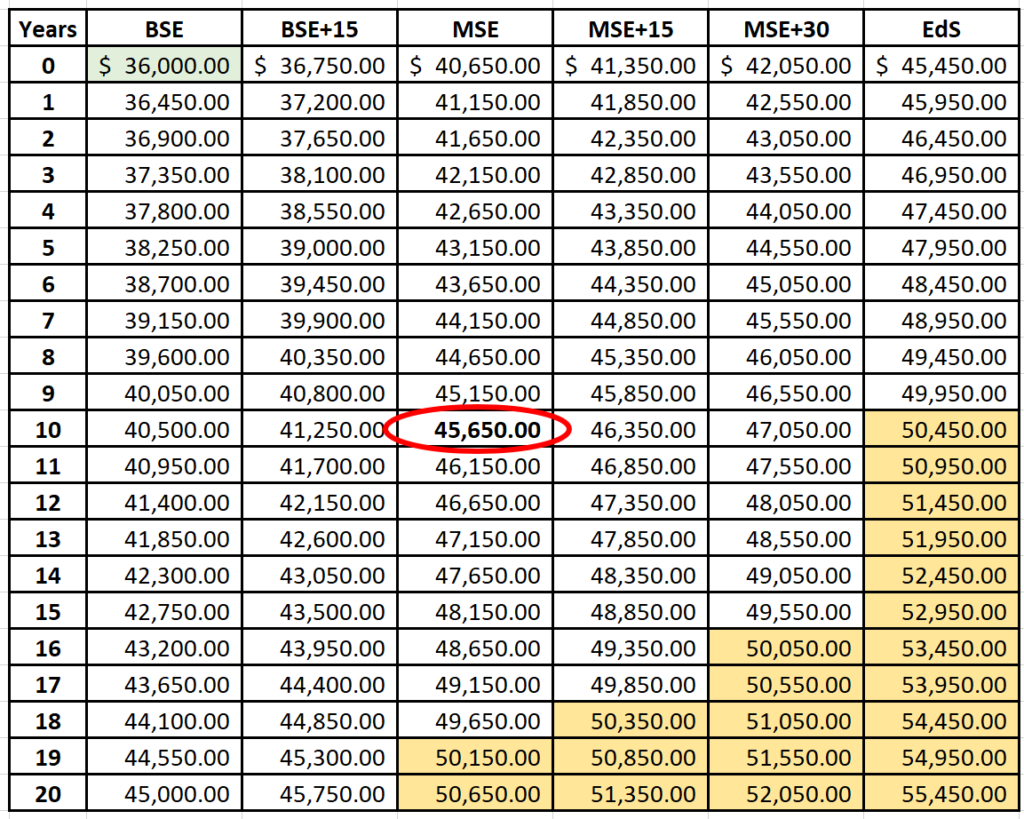
The step formula is very simple. BSE teacher salaries increase $450 for each additional year of service. MSE salaries start at $4,650 more than a BSE and increase $500 for each additional year of service. Those with an EdS degree start at $3,400 more than a MSE and increase $500 for each additional year of service.
Tables of data can be difficult to absorb, so here is a chart showing the old minimum salary schedule with a cross section of different degrees and years of experience to visually accentuate the steps. The red represents the COLA applied to each step. The result is straight forward – the COLA adds a little bump to each step, and each step remains proportionate:
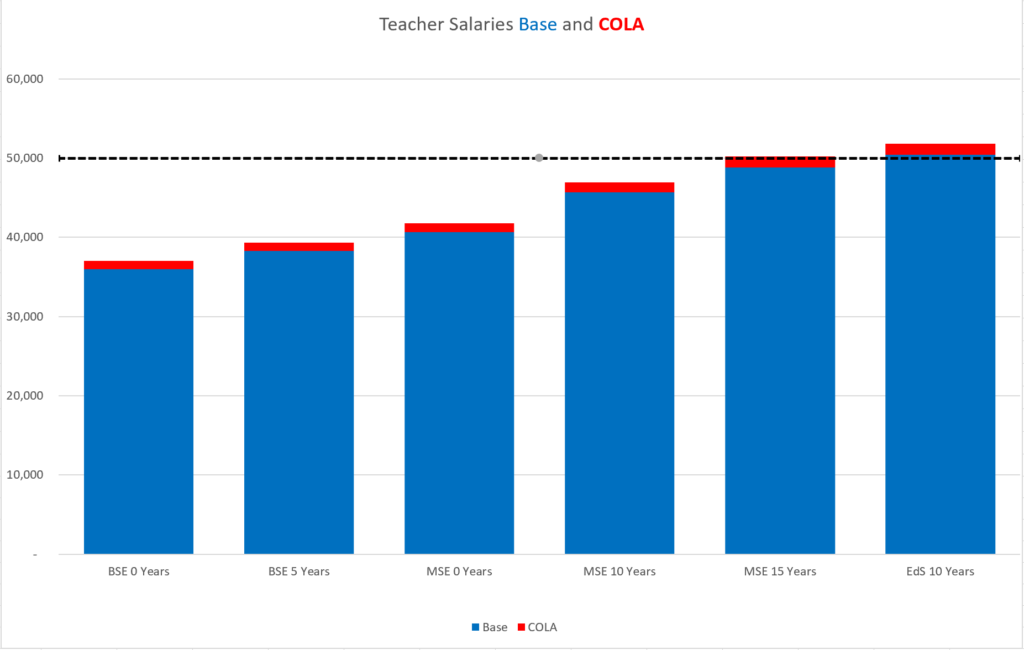
The Adequacy Reports from both the House and Senate Education Committees recommended an across the board $4,000 increase for every teacher. Likewise, House Bill 1268 filed by democrats proposed an across the board increase to the state minimum salary schedule to preserve all the step increases. However, HB1268 increased salaries by $14,000 in order to bring the lowest step up to $50,000. In this schedule, a new teacher who was hired fresh out of college with a bachelor’s degree for $36,000 starts out $14,000 higher at $50,000. The teacher with a master’s and 10 years of experience gets a $14,000 raise, as well as every other teacher:
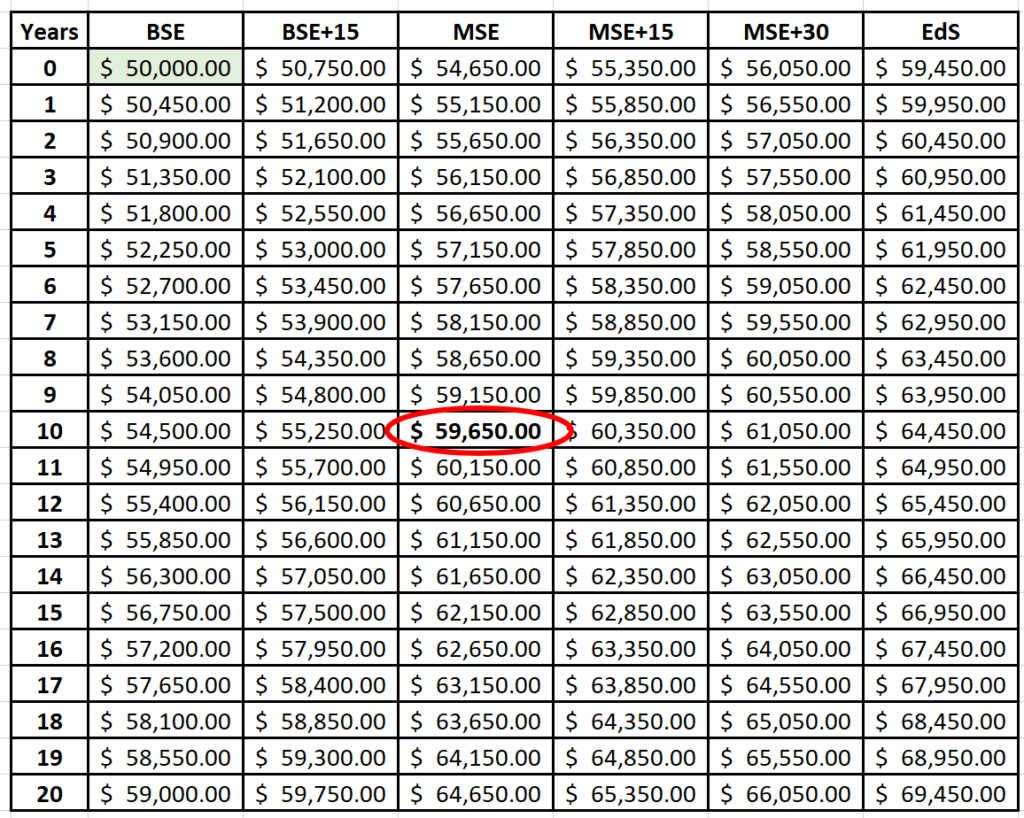
This is the cross section chart used above modified to show the effect of an across the board $14,000 raise:
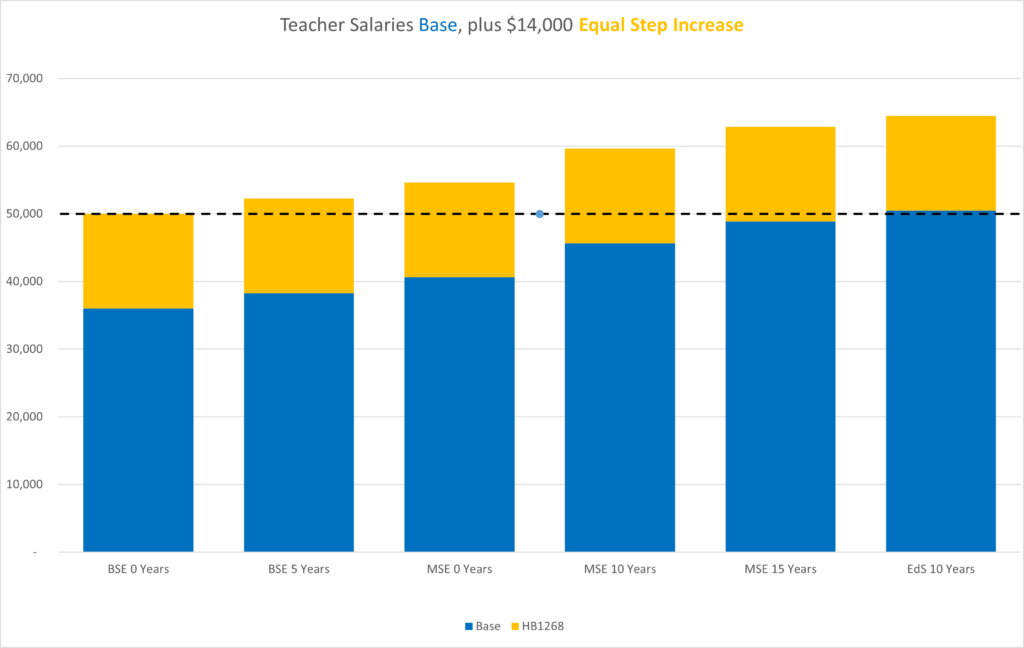
But that is not what the LEARNS Act does. It only funds closing the gap to get everyone up to the $50,000 minimum or adds the $2,000 bump, whichever is greater. With there being no other new money to rebuild a salary schedule with steps comparable to the old one, the following is the resulting schedule being implemented by several districts across the state for next year:
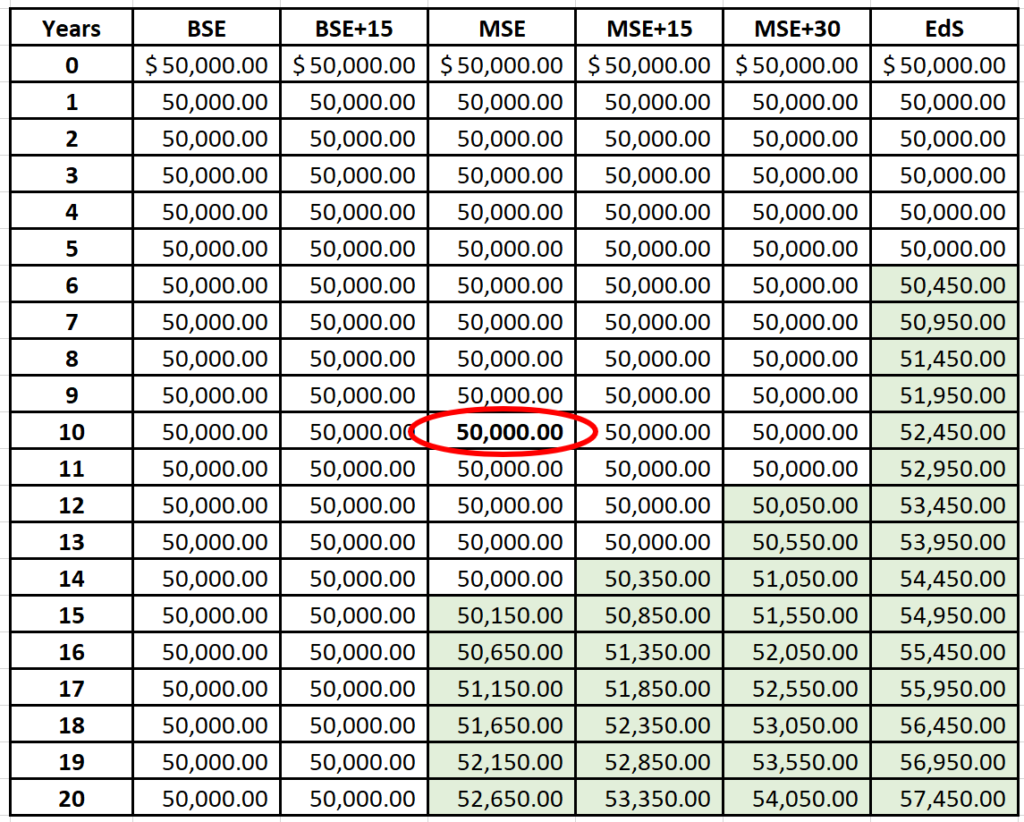
Nearly all the steps have been removed. The ones in green are the steps over $48,000 that existed under the old schedule with the $2,000 bump added. A new teacher still starts $14,000 higher at $50,000, but the teacher with 10 years of experience and a Master’s will only see an increase of $4,350, and they both make $50,000. Increased pay for years of service and advanced degrees vanishes except for the most veteran teachers with advanced degrees, and even then, it is only $2,000 more than the old schedule. This is the cross section chart of what LEARNS looks like:
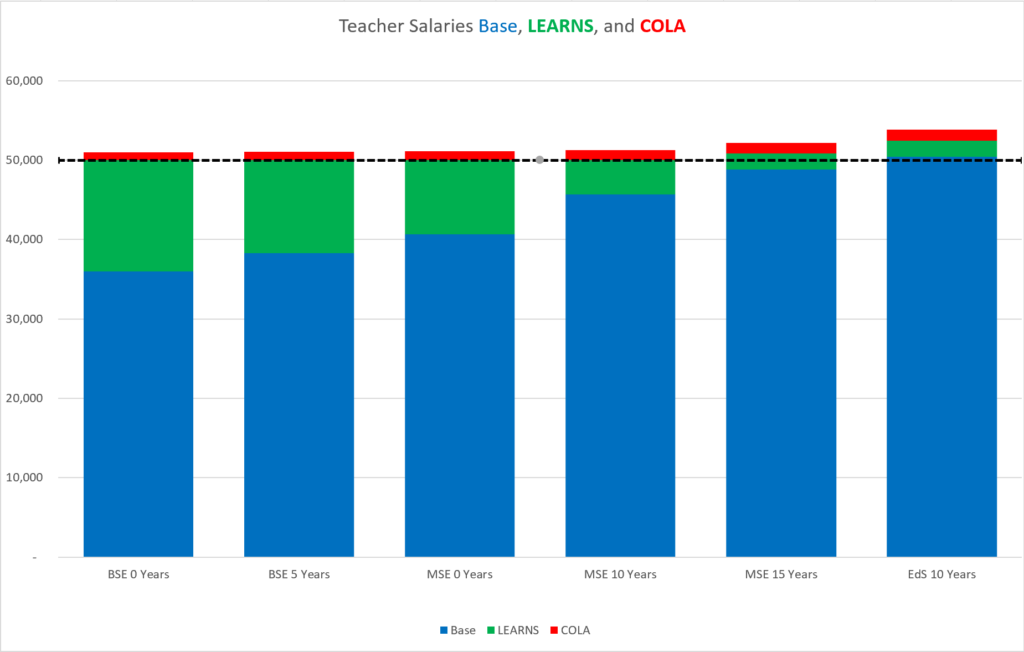
Officials suggest is since the lower salaries already get a hefty jump, the little red slices of COLA increase in the foundation matrix could be shifted to other steps to create a schedule. But building out fully proportionate steps with those little red slices of COLA at each level isn’t going to work.
Recall that ADE tweeted “districts are welcome to cover costs that go above [what LEARNS contributes]”. It would cost the district $9,650 to maintain a proportionate schedule with the old one for just the one teacher in the example above. It is very much akin to saying “Everyone is welcome to go buy themselves a billion dollar mega yacht”. The reality is there is nowhere near enough money available to cover the costs for districts to offer proportionate increased pay for years of service and advanced degrees – unless they cut programs or convince voters to raise property taxes.
By eliminating the state minimum schedule and not providing funding beyond closing the gap for those below $50,000, the state has effectively set a $50,000 minimum salary which is also a $50,000 maximum salary, except for some very senior teachers with advanced degrees.
So it is true to say the state isn’t contributing enough money to put much focus on retaining veteran teachers with advanced degrees.
Would you work for 10 to 20 years with no opportunity for a pay raise?
Unfunded Item #5 – Inflation
Meanwhile, back in the world of numbers that are easier to understand: LEARNS adds insult to injury where inflation is concerned. As noted in this thread by Searcy High School teacher Tervor McGarrah, for any teacher currently making $47,000 or more, neither the minimum salary nor the additional $2,000 bump keeps up with inflation. As such, those pay increases relative to inflation are actually pay decreases:
As previously noted, the 2.77% increase in foundation funding is far outpaced by inflation. If any of that increase is used for salaries, it will eat into what is available to pay all the other bills.
Circumstantially Unfunded Item #6? – The Bump
What exactly is the $2,000 bump? Is it a permanent salary increase, or a one-time bonus? Officials have said it is an increase, but a lot of things officials have said are not actually spelled out. The law refers to it as an increase at one point. One thing for certain is that it is yet another Arkansas LEARNS lawsuit waiting to happen. This is the text establishing it:

Like the text of many other Arkansas statutes, it is horribly written. It says “for the 2023-2024 school year”. What about years after that? Does that mean only for 2023-2024, and it goes away for 2024-2025? Will it drop a teacher making $54,000 with the $2,000 increase back to $52,000?
And what about the circumstance where a teacher with 10 years of experience and a master’s degree is working in a high paying district like the Little Rock school district making $60,099 as of September 1, 2022, but then they move to a district next year where a Master’s +10 years only pays $50,000? Should they make $62,099? This was ADE’s response to that question:
As noted in my reply, that most certainly not what the law says:
The way it is currently written seems to make it a minimum teacher salary voucher that follows the teacher if they move to a different school district.
Years of Service
During the sponsors’ Arkansas code strikeout fever dream, they also eliminated all statutory definitions of years of service. Rather than having a uniform definition of years of service across school districts, each of the 259 schools districts can now make up their own individual definition of how service years are measured.6
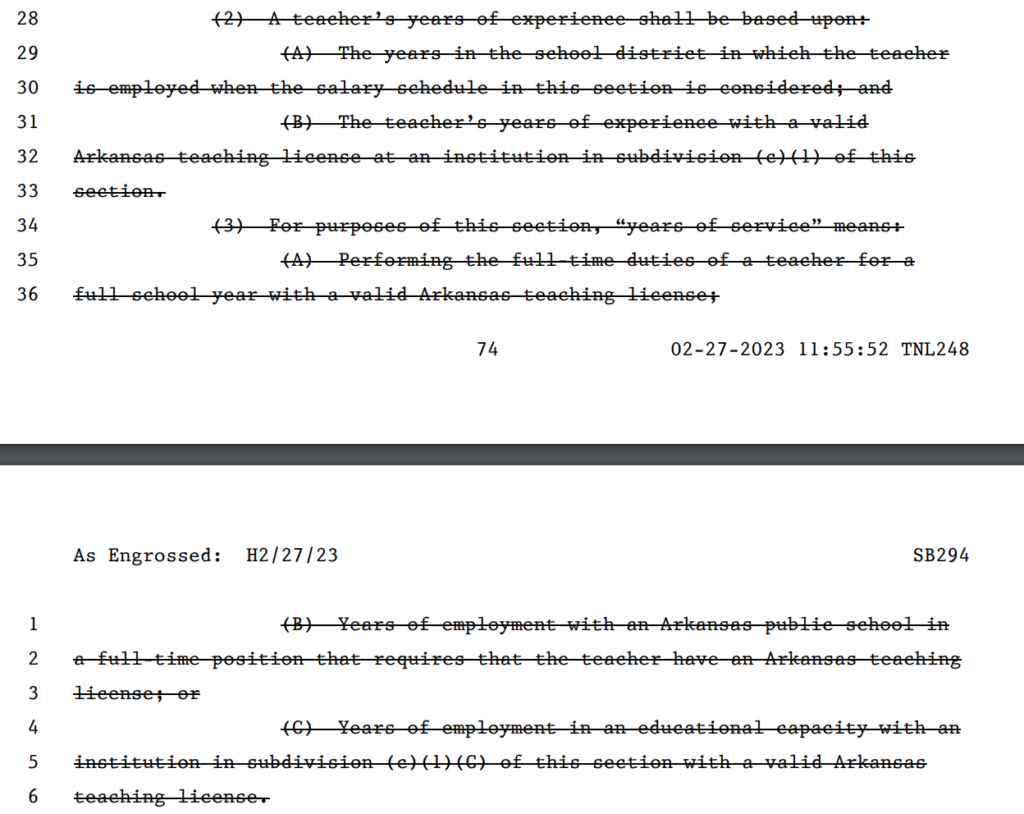
To Implement, and Beyond!
One caveat related to salaries being “100% funded by LEARNS” is the law states that it establishes a fund to “implement” the minimum salaries, but it does not specifically require that the entire pay gap be fully covered.7

Implement – to put into effect. The text of the statute doesn’t specify what exactly the state will do to implement the minimum salary. They have said they will give districts enough money to close the gap to get teachers up to $50,000 and provide funds for benefits. The details of that are not in the law. Will they make good on their “I’m a politician, trust me” promise? Is there only going to be funding to implement but not maintain the salaries? Does this last forever? The law doesn’t say. They already put schools on the hook for all the above referenced items.
What about ongoing maintenance of the minimum salary? Will the “completely different pot” created by LEARNS get funded every year, and if so, what’s the formula for that? Will all of LEARNS eventually merge into foundation funding? All of this is coming from the big budget surplus. What happens to teacher salaries in an economic downturn and there is no surplus?
But rest assured, if anyone has any questions about teacher salaries, ADE will set the record straight with a helpful answer that is full of insight, though you might want to provide them a link to the law so they can find the answer.

***
If you like what we are doing here and find Blue Hog Report to be a valuable part of Arkansas politics, please consider subscribing to our Patreon page.
May cause incontinence or temporary blindness while driving. Read at your own risk. Void where prohibited.↩
Put a pin in calling that $2,000 a “bump”. We will come back to that in a bit.↩
ADE – please cite a specific page/line if I am wrong on that – Here is the link to the law: https://bit.ly/3LOmzpY.↩
But will it actually increase though? Spoiler alert!↩
The +15 and +30 designators are for how many additional post-graduate level credit hours the teacher has.↩
ADE – please cite a specific page/line if I am wrong on that – Here is the link to the law: https://bit.ly/3LOmzpY.↩
ADE – please cite a specific page/line if I am wrong on that – Here is the link to the law: https://bit.ly/3LOmzpY.↩